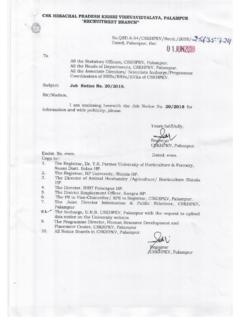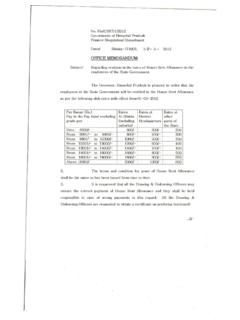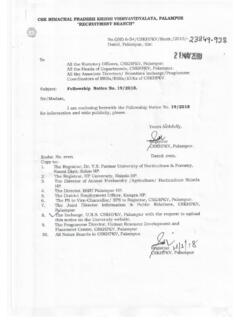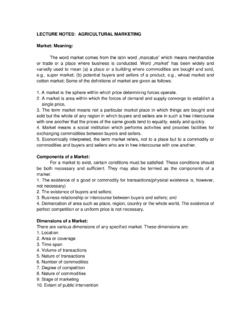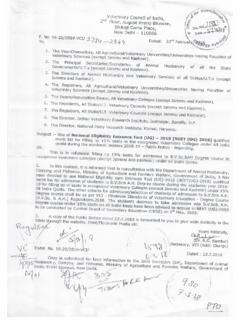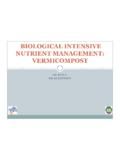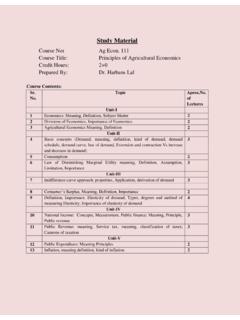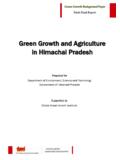Transcription of Current Trends in Agronomy - Himachal Pradesh …
1 Current Trends in Agronomy (2012-13). Department of Agronomy , College of Agriculture, CSK Himachal Pradesh Krishi Vishvavidyalaya, Palampur-176062 (India). Current Trends in Agronomy SS Rana Sr Scientist Department of Agronomy , Forages and Grassland Management, COA, CSK HPKV, Palampur-176062. SYLLABUS. AGRON 601 3+0. Objective To acquaint the students about recent advances in agricultural production Theory UNIT I. Agro-physiological basis of variation in yield, recent advances in soil plant-water relationship UNIT II. Globalization of agriculture and WTO, precision agriculture, contract farming, organic farming, marketing and export potential of organic products, certification, labeling and accreditation procedures UNIT III.
2 Crop residue management in multiple cropping systems; latest developments in plant management, weed management, cropping systems, grassland management, agro- forestry, allelopathy UNIT IV. GIS, GPS and remote sensing for crop management, global warming, GM crops, seed production technology; seed certification, seed multiplication, hybrid seed production, etc. UNIT V. Concepts of system approach in agriculture; holistic approach of farming systems, dryland farming, sustainable agriculture and research methodology in Agronomy Suggested Readings Agarwal RL. 1995. Seed Technology. Oxford & IBH. Dahiya BS & Rai KN. 1997. Seed Technology.
3 Kalyani Publishers. Govardhan V. 2000. Remote Sensing and Water Management in Command Areas: Agroecological Prospectives. IBDC. ICAR. 2006. Hand Book of Agriculture. ICAR, New Delhi. Narasaiah ML. 2004. World Trade Organization and Agriculture. Sonali Publ. Palaniappan SP & Annadurai K. 2006. Organic Farming - Theory and Practice. Scientific Publishers. Sen S & Ghosh N. 1999. Seed Science and Technology. Kalyani Publishers. Tarafdar JC, Tripathi KP & Mahesh Kumar 2007. Organic Agriculture. Scientific Publishers. Contents Topic Page UNIT I. Agro-physiological basis of variation in yield 1. Recent advances in soil plant-water relationship 10.
4 UNIT II. Globalization of agriculture and WTO 20. Precision agriculture 24. Contract farming 27. Organic farming, marketing and export potential of organic products, certification, 35. labeling and accreditation procedures UNIT III. Crop residue management in multiple cropping systems; 49. Latest developments in plant management, weed management, cropping systems, 53. grassland management, agro-forestry, allelopathy UNIT IV. GIS, GPS and remote sensing for crop management 71. Global warming 79. GM crops 82. Seed production technology; seed certification, seed multiplication, hybrid seed 85. production, etc. UNIT V. Concepts of system approach in agriculture 98.
5 Holistic approach of farming systems 104. Dryland farming 107. Sustainable agriculture 115. Research methodology in Agronomy 120. Distribution of marks Hourly examination 10%. Mid-term 20-30%. Assignments 5%. End of term examination including practical 55-65%. Current Trends IN Agronomy 2012-13. Agro- Agro-physiological basis of variation in yield Physiological aspects of photosynthesis and respiration have to be demonstrated in sorting out the regulation and function of various components. If there are inefficiencies in these systems and if causes can be identified, they would represent legitimate targets for genetic manipulation.
6 Properties of rubisco, alternative oxidase, and photorespiration process already loom as opportunities for genetic manipulation. However, about their utilities we are yet uncertain. Serious reinvestigation of foliage canopies offers promise for important gains in photosynthetic productivity of crops. First cycle of such research, begun over 50 years ago, in which importance of strong advantages of erect leaves in dense canopies and minimum interception by emergent reproductive structures was demonstrated. Those properties are now credited with contributing to yield progress in maize (Fischer and Evans, 1999). Plant production is driven by photosynthesis.
7 Key elements in the system are: (i) the interception of photosynthetically active radiation (PAR, 400-700 nm spectral band), (ii) use of that energy in the reduction of CO2 and other substrates (photosynthesis), (iii) incorporation of assimilates into new plant structures (biosynthesis and growth), and (iv) maintenance of plant as living unit. Achieving high yield is conceptually simple- maximize the extent and duration of radiation interception;. use captured energy in efficient photosynthesis;. partition new assimilates in ways that provide optimal proportions of leaf, stem, root, and reproductive structures; and maintain those at minimum cost.
8 Crop yield comprises only a portion of biomass that accumulates over a crop cycle. Effective root and canopy systems (including stem structure for foliage display), for example, generally must be established before onset of reproductive phase. In addition, cost of maintenance increases as vegetative biomass accumulates during season. Because crops are at mercy of spatial and temporal variations in weather, plant spacing, supplies of water and nutrients, and in occurrence of pests and disease. Therefore, flexibility in morphogenesis and acclimation of physiological systems is a key requirement for achieving high and stable performance.
9 Whether biological efficiency of these processes has, or might be, improved through breeding are important questions. Biomass and Other Morphological Traits Just as impact of Green Revolution can be attributed mostly to improved partitioning of products of photosynthesis to grain yield, progress in yield is strongly associated with improved harvest index (HI). Morphological traits associated with increased yield potential include grain number and HI. Even if HI could be raised to 60% from its Current maximum value (50%), it implies that yields could only be increased by a further 20% using HI as a selection criterion, unless total crop biomass is also raised.
10 Furthermore, improved partitioning by greater reduction in plant height is unlikely since research suggests that optimal plant heights have already been achieved. Some studies have shown increased biomass to be associated with yield increases. Photosynthesis and Related Traits By definition, improved yield cannot be attributed to better overall radiation use efficiency (RUE) in cases where total biomass has not been improved. RUE in a crop context represents ratio of total energy present in crop's biomass to that of solar energy incident on crop across its growth cycle. The pre-anthesis vegetative growth rates were lower for most modern cultivars.
